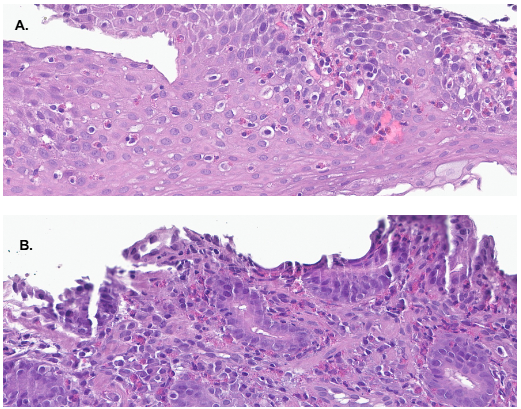Tuesday Poster Session
Category: Biliary/Pancreas
P4519 - Rash, Abdominal Pain, and the Clue in CBC: A Case of Recurrent Pancreatitis Revealing Hypereosinophilic Syndrome
Tuesday, October 28, 2025
10:30 AM - 4:00 PM PDT
Location: Exhibit Hall

Chinmay Guralwar, MBBS (he/him/his)
Mayo Clinic
Rochester, MN
Presenting Author(s)
Chinmay Guralwar, MBBS, Gerardo Calderon, MD, Adam C. Bledsoe, MD, Joseph Murray, MD
Mayo Clinic, Rochester, MN
Introduction: Hypereosinophilic syndrome (HES) is a rare group of disorders defined as an elevation in absolute eosinophil count (AEC) ( >1.5 x 10^9/L on two or more occasions at least four weeks apart) in the absence of identifiable causes such as parasitic infection or hematologic malignancy, and eosinophil-associated organ damage. This report highlights the successful management of HES presenting as recurrent episodes of pancreatitis.
Case Description/
Methods: A 21-year-old male with ankylosing spondylitis, asthma, and Gilbert’s syndrome presented with history of recurrent abdominal pain for over 30 months. His first episode of pancreatitis occurred 24 months ago and has since experienced six such episodes. During these episodes he reported abdominal pain, generalized rashes, and had lipase levels ranging from 340-1120 U/L (upper normal limit 60U/L). On imaging (CT, EUS, ERCP, MRCP) there was no evidence of acute or chronic pancreatitis. Labs revealed an AEC of 1.84×10⁹/L, with previous elevations of 2.02x10⁹/L and 1.73×10⁹/L noted on two occasions within the past year, each more than four weeks apart, along with markedly elevated IgE level (4440 IU/mL). Endoscopic biopsies revealed esophageal (35/HPF) and gastric (70/HPF) eosinophilia (Figure 1). Patient was started on Ivermectin based on a positive Strongyloides IgG test, but it yielded no benefit. On bone marrow biopsy hypereosinophilia (18%) was noted along with no findings suggestive of malignancy. Mepolizumab (anti-IL5) was initiated four months after presentation, leading to normalization of eosinophil counts, no recurrence of pancreatitis, and marked improvement in baseline abdominal symptoms.
Discussion: HES is an extremely rare condition and is considered a diagnosis of exclusion. In this case, treatment was initiated only after comprehensive investigations ruled out other known causes of eosinophilia. The case highlights the value of clinical suspicion and the role of basic investigations such as CBC in identifying potential HES. Early recognition is crucial and can help reduce misdiagnosis in this rare but treatable condition.

Figure: Figure 1: A) Endoscopic biopsy of the esophagus (40x magnification) showing intraepithelial eosinophils (35 eosinophils per high-power field). B) Endoscopic biopsy of the gastric antrum (40x magnification) showing increased antral eosinophils (up to 70 eosinophils per high-power field).
Disclosures:
Chinmay Guralwar indicated no relevant financial relationships.
Gerardo Calderon indicated no relevant financial relationships.
Adam Bledsoe: Anokion/Kanyos Bio – Grant/Research Support. Barinthus Bio – Grant/Research Support. Chugai Pharma – Grant/Research Support. Sanofi – Grant/Research Support. Takeda – Grant/Research Support.
Joseph Murray indicated no relevant financial relationships.
Chinmay Guralwar, MBBS, Gerardo Calderon, MD, Adam C. Bledsoe, MD, Joseph Murray, MD. P4519 - Rash, Abdominal Pain, and the Clue in CBC: A Case of Recurrent Pancreatitis Revealing Hypereosinophilic Syndrome, ACG 2025 Annual Scientific Meeting Abstracts. Phoenix, AZ: American College of Gastroenterology.
Mayo Clinic, Rochester, MN
Introduction: Hypereosinophilic syndrome (HES) is a rare group of disorders defined as an elevation in absolute eosinophil count (AEC) ( >1.5 x 10^9/L on two or more occasions at least four weeks apart) in the absence of identifiable causes such as parasitic infection or hematologic malignancy, and eosinophil-associated organ damage. This report highlights the successful management of HES presenting as recurrent episodes of pancreatitis.
Case Description/
Methods: A 21-year-old male with ankylosing spondylitis, asthma, and Gilbert’s syndrome presented with history of recurrent abdominal pain for over 30 months. His first episode of pancreatitis occurred 24 months ago and has since experienced six such episodes. During these episodes he reported abdominal pain, generalized rashes, and had lipase levels ranging from 340-1120 U/L (upper normal limit 60U/L). On imaging (CT, EUS, ERCP, MRCP) there was no evidence of acute or chronic pancreatitis. Labs revealed an AEC of 1.84×10⁹/L, with previous elevations of 2.02x10⁹/L and 1.73×10⁹/L noted on two occasions within the past year, each more than four weeks apart, along with markedly elevated IgE level (4440 IU/mL). Endoscopic biopsies revealed esophageal (35/HPF) and gastric (70/HPF) eosinophilia (Figure 1). Patient was started on Ivermectin based on a positive Strongyloides IgG test, but it yielded no benefit. On bone marrow biopsy hypereosinophilia (18%) was noted along with no findings suggestive of malignancy. Mepolizumab (anti-IL5) was initiated four months after presentation, leading to normalization of eosinophil counts, no recurrence of pancreatitis, and marked improvement in baseline abdominal symptoms.
Discussion: HES is an extremely rare condition and is considered a diagnosis of exclusion. In this case, treatment was initiated only after comprehensive investigations ruled out other known causes of eosinophilia. The case highlights the value of clinical suspicion and the role of basic investigations such as CBC in identifying potential HES. Early recognition is crucial and can help reduce misdiagnosis in this rare but treatable condition.

Figure: Figure 1: A) Endoscopic biopsy of the esophagus (40x magnification) showing intraepithelial eosinophils (35 eosinophils per high-power field). B) Endoscopic biopsy of the gastric antrum (40x magnification) showing increased antral eosinophils (up to 70 eosinophils per high-power field).
Disclosures:
Chinmay Guralwar indicated no relevant financial relationships.
Gerardo Calderon indicated no relevant financial relationships.
Adam Bledsoe: Anokion/Kanyos Bio – Grant/Research Support. Barinthus Bio – Grant/Research Support. Chugai Pharma – Grant/Research Support. Sanofi – Grant/Research Support. Takeda – Grant/Research Support.
Joseph Murray indicated no relevant financial relationships.
Chinmay Guralwar, MBBS, Gerardo Calderon, MD, Adam C. Bledsoe, MD, Joseph Murray, MD. P4519 - Rash, Abdominal Pain, and the Clue in CBC: A Case of Recurrent Pancreatitis Revealing Hypereosinophilic Syndrome, ACG 2025 Annual Scientific Meeting Abstracts. Phoenix, AZ: American College of Gastroenterology.
